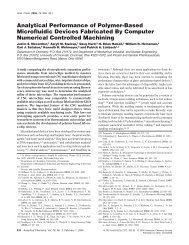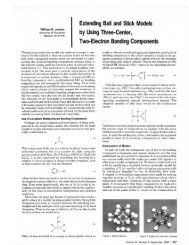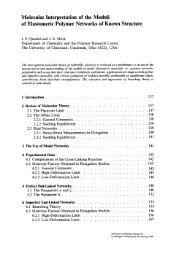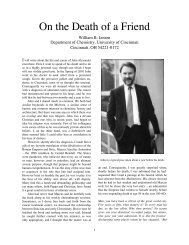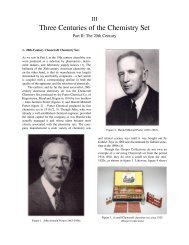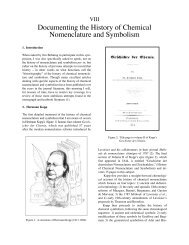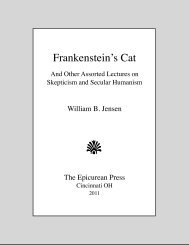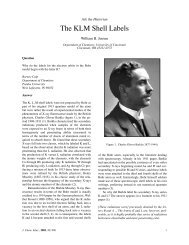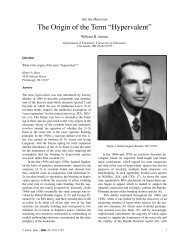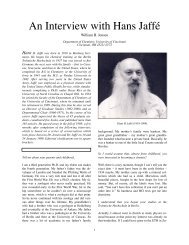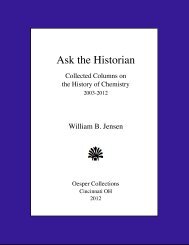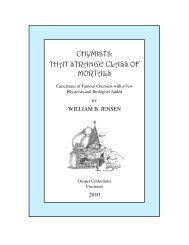The Leyden and Stockholm Papyri - University of Cincinnati
The Leyden and Stockholm Papyri - University of Cincinnati
The Leyden and Stockholm Papyri - University of Cincinnati
Create successful ePaper yourself
Turn your PDF publications into a flip-book with our unique Google optimized e-Paper software.
GENERAL INTRODUCTION<br />
complete translations in the form <strong>of</strong> a series <strong>of</strong> articles published in<br />
the newly founded Journal <strong>of</strong> Chemical Education, <strong>and</strong> it is these<br />
articles <strong>and</strong> translations which form the basis <strong>of</strong> this present edition<br />
(11, 12).<br />
! As a reading <strong>of</strong> these translations quickly reveals, neither<br />
papyrus contains the mystical symbolism <strong>and</strong> allegorical indirection<br />
so typical <strong>of</strong> the true alchemical literature. Rather they consist<br />
largely <strong>of</strong> simple, short recipes. In the case <strong>of</strong> the <strong>Leyden</strong> papyrus<br />
these focus primarily on the preparation <strong>of</strong> various metal alloys –<br />
many <strong>of</strong> which are intended to imitate the appearance <strong>of</strong> either gold or<br />
silver – for use in making jewelry, in gilding, or in metallic writing,<br />
while a few others deal instead with dyes <strong>of</strong> various sorts. <strong>The</strong><br />
contents <strong>of</strong> the <strong>Stockholm</strong> papyrus have the same form, but focus<br />
more on dyeing <strong>and</strong> the imitation <strong>of</strong> various precious stones <strong>and</strong><br />
gems. Both papyri explicitly acknowledge that the alloys <strong>and</strong> gems<br />
which they describe are imitations <strong>and</strong> not the real thing. Indeed,<br />
so simple <strong>and</strong> safe are some <strong>of</strong> the recipes that they have actually<br />
been proposed as potential laboratory preparations for use in<br />
connection with a modern-day history <strong>of</strong> chemistry course (13).!!<br />
! Kopp, in his original description <strong>of</strong> the <strong>Leyden</strong> papyrus,<br />
referred to it as “Die älteste chemische H<strong>and</strong>schrift,” – the oldest<br />
chemical manuscript – a characterization that has been generally<br />
accepted by most subsequent chemical historians. Thus it is somewhat<br />
ironic that, even as Caley was making his translations in late<br />
1925, that status was being seriously challenged by work in the<br />
field <strong>of</strong> Assyriology. For that same year the British Assyriologist,<br />
R. Campbell Thompson, <strong>and</strong> the German Assyriologist, H. Zimmern,<br />
each independently published transliterations <strong>and</strong> translations <strong>of</strong><br />
several cuneiform tablets dating from the 7th century BC containing<br />
practical recipes for the preparation <strong>of</strong> colored glasses (14, 15)<br />
– a subject which is surely as legitimately chemical in content as<br />
are the preparations <strong>of</strong> the alloys, inks, dyes <strong>and</strong> artificial gems<br />
described in the <strong>Leyden</strong> <strong>and</strong> <strong>Stockholm</strong> papyri. Though these<br />
translations are now over 85 years old, they have remained<br />
relatively unknown to most historians <strong>of</strong> chemistry, despite the<br />
more recent publication <strong>of</strong> an impressive <strong>and</strong> definitive edition <strong>of</strong><br />
the relevant cuneiform texts by Oppenheim et al. (16).<br />
- 3 -



